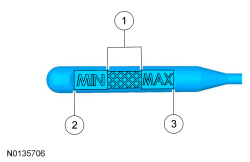SECTION 307-02: Transaxle/Transmission Cooling
| 2014 Flex Workshop Manual
|
DIAGNOSIS AND TESTING
| Procedure revision date: 05/02/2013
|
Transaxle Cooling
Special Tool(s)
 | Vehicle Communication Module (VCM) and Integrated Diagnostic System (IDS) software with appropriate hardware, or equivalent scan tool
|
Material
| Item
| Specification
|
|---|
Motorcraft® MERCON® LV Automatic Transmission Fluid
XT-10-QLVC (US); CXT-10-LV12 (Canada)
| MERCON® LV
|
Inspection and Verification
- Verify the customer concern by operating the vehicle to duplicate the condition.
- If the inspection reveals obvious concern(s) that can be readily identified, repair as necessary.
- Install new components if a transmission fluid leak is found in any of the transmission cooling components.
- If the concern(s) remains after the inspection, determine the symptom(s). GO to
Symptom Chart - Transaxle Cooling
or GO to
Symptom Chart - NVH
.
Symptom Chart — Transmission Cooling
Symptom Chart — Transmission Cooling
| Condition
| Possible Sources
| Action
|
|---|
| - Clogged transmission fluid cooler or transmission fluid cooler tubes
- Bent or crushed transmission fluid cooler tubes
- Transmission fluid cooler thermal bypass valve stuck closed
| - INSPECT the transmission fluid cooler, transmission fluid cooler tubes and transmission fluid cooler thermal bypass valve for damage or plugging. INSTALL new components as necessary.
|
| | - INSPECT transmission fluid cooler and transmission fluid cooler tubes for leaks. SERVICE as required.
|
| - Internal transmission concerns
| |
Symptom Chart — NVH
Symptom Chart — NVH
NOTE:
NVH symptoms should be identified using the diagnostic tools that are available. For a list of these tools, an explanation of their uses and a glossary of common terms, refer to
Section 100-04
. Since it is possible any one of multiple systems may be the cause of a symptom, it may be necessary to use a process of elimination type of diagnostic approach to pinpoint the responsible system. If this is not the causal system for the symptom, refer back to
Section 100-04
for the next likely system and continue diagnosis.
| Condition
| Possible Sources
| Action
|
|---|
- Vibration — a high frequency (20-80 Hz) that is felt through the seat or gear shifter. Changes with engine speed
| - Transmission fluid cooler tubes grounded
| - CHECK the transmission fluid cooler tubes. REPAIR as necessary.
|
Check Transmission Fluid Level and Condition
NOTICE:
The vehicle should not be driven if the transmission fluid level indicator shows the transmission fluid below the minimum transmission fluid level mark or internal failure could result.
If the vehicle has been operated for an extended period of time, at highway speeds, in city traffic, in hot weather or while pulling a trailer, the transmission fluid needs to cool down to obtain an accurate reading.
The transmission fluid level reading on the transmission fluid level indicator will differ depending on operating and ambient temperatures. The correct reading should be within the normal operating temperature range.
Transmission Fluid Level Check
NOTE:
The transmission fluid should be checked at normal operating temperature 82°C-93°C (180°F-200°F) on a level surface. Normal operating temperature can be reached after approximately 32 km (20 mi) of driving.
Under normal circumstances, the transmission fluid level should be checked during normal maintenance. If the transmission starts to slip, shifts slowly or shows signs of transmission fluid leaking, the transmission fluid level should be checked.
- With the transmission in PARK, the engine at idle, foot pressed on the brake, move the selector lever through each gear and allow engagement of each gear. Place the selector lever in the PARK position.
- Wipe the transmission fluid level indicator cap and remove the transmission fluid level indicator.
- Wipe the transmission fluid level indicator with a clean cloth.
- Install the transmission fluid level indicator back in the transmission until it is fully seated, then remove the indicator. The transmission fluid level should be within the normal operating range.

| Item
| Description
|
|---|
| 1
| Correct transmission fluid level at normal operating temperature 82°C-93°C (180°F-200°F)
|
| 2
| Low transmission fluid level
|
| 3
| High transmission fluid level
|
High Transmission Fluid Level
A transmission fluid level that is too high may cause the transmission fluid to become aerated due to the churning action of the rotating internal parts. This will cause erratic control pressure, foaming, loss of transmission fluid from the vent tube and possible transmission malfunction and/or damage.
Low Transmission Fluid Level
A low transmission fluid level could result in poor transmission engagement, slipping, malfunction and/or damage. This could also indicate a leak in one of the transmission seals or gaskets.
Adding Transmission Fluid
NOTICE:
The use of any transmission fluid other than what is recommended for this transmission will cause transmission damage.
If transmission fluid needs to be added, add transmission fluid in 0.25L (1/2 pt) increments to the transmission. Do not overfill the transmission. For transmission fluid type, refer to Specifications in this section.
Transmission Fluid Condition Check
- Check the transmission fluid level.
- Hold the transmission fluid level indicator over a white facial tissue and allow the transmission fluid to drip onto the facial tissue and examine the stain.
- If evidence of solid material is found, the transmission fluid pan should be removed for further inspection.
- If transmission fluid contamination or transmission failure is confirmed by the sediment in the bottom of the transmission fluid pan, repair the transmission and clean the transmission fluid cooler tubes and the transmission fluid cooler.
- If the transmission is to be overhauled or if installing a new transmission, the transmission fluid cooler must be backflushed. Refer to
Transmission Fluid Cooler Backflushing and Cleaning
.


